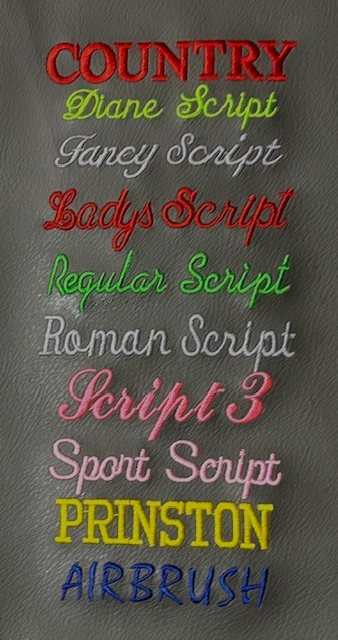Heat Transfer on T-Shirts and Aprons - Personalized Layouts and Logo Designs
Heat Transfer on T-Shirts and Aprons - Personalized Layouts and Logo Designs
Blog Article
The Art of Custom Needlework: Unlocking the Keys to Creating Unique and Memorable Designs
The tricks to creating custom embroidery layouts that astound the eye and leave a long lasting perception lie in a delicate balance of strategy, creative thinking, and interest to detail. As we delve into the globe of customized needlework, we uncover the nuanced interplay between thread selection, sew intricacy, and layout customization that boosts a simple garment to a job of art.
Selecting the Right Needlework Threads
When selecting embroidery threads, what crucial aspects should you consider to make sure the best results for your custom-made layouts? The choice of embroidery string is essential in figuring out the final outcome of your stitched design. One of the primary considerations is the product of the thread. Different products such as cotton, polyester, rayon, and silk supply differing levels of sheen, longevity, and texture. It is necessary to choose a string material that matches the textile you are stitching on and aligns with the desired look of the style.
Additionally, the weight or density of the thread plays a considerable role in the appearance of the needlework. Thicker strings can include measurement and appearance to your layout, while finer strings are excellent for detailed information and small text. In addition, taking into consideration the shade fastness and washability of the string is vital to make sure that your custom designs keep their top quality and vibrancy gradually. By meticulously reviewing these elements and selecting high-quality strings that fulfill your details demands, you can enhance the visual appeal and long life of your stitched developments.
Exploring Different Stitch Strategies
To look into the realm of 'Discovering Various Stitch Strategies', one should realize the ins and outs and nuances that each sewing technique offers the art of embroidery. Various stitch techniques not just include visual passion yet also add to the overall structure and measurement of the design. One popular stitch method is the satin stitch, which entails closely packed parallel stitches to create a smooth and glossy surface, suitable for completing forms and creating strong outlines.
On the other hand, the backstitch is a versatile method often used for detailing and adding great information. It involves sewing backwards to create a solid line of needlework. In addition, the French knot stitch includes a tactile component to designs, ideal for producing textured accents like blossom facilities or attractive touches.
Discovering various stitch techniques allows embroiderers to play with light, shadow, and depth within their designs, elevating the visual allure and artistic high quality of their needlework tasks. By mastering various stitching methods, one can open limitless opportunities for developing one-of-a-kind and remarkable try these out customized needlework items.
Incorporating Personalized Layout Components
Having actually discovered the details of various stitch methods such as the satin stitch, backstitch, and French knot, the focus now shifts in the direction of incorporating tailored design elements in custom needlework tasks. Individualized design components play a crucial role in making needlework jobs truly one-of-a-kind and memorable. One means to include customization is by adding initials, names, or significant days to the design. This not just adds a customized touch yet likewise improves the nostalgic worth of the embroidery item.
One more means to integrate tailored layout elements is by consisting of symbols or motifs that hold unique definition to the recipient or show their interests and individuality. As an example, including a favorite blossom, pet, or hobby-related symbol can make the needlework design a lot more significant and customized. Additionally, selecting colors that reverberate with the recipient or line up with the intended style can better enhance the personalization of the needlework task.
Understanding the Art of Shade Coordination

One secret facet of color control is recognizing color theory. This consists of understanding just visit here how different colors connect with check my reference each other, the emotions they convey, and exactly how they can be incorporated to create visually attractive layouts. By using color concept concepts, embroiderers can create harmonious shade schemes that boost the general appearance of the design.
Furthermore, focusing on comparison is important in color sychronisation. Using contrasting shades can help certain aspects of the style pop, enhance clarity, and develop an aesthetically dynamic embroidery piece. By mastering the art of shade coordination, embroiderers can boost their designs and develop unforgettable items that reverberate with clients and audiences alike.
Enhancing Structure With Advanced Needlework Stitches
French knots, for instance, are perfect for adding small, increased dots to your style, resembling the look of grains or developing a distinctive surface area. Bullion knots, on the other hand, can be used to produce twisted, ropelike aspects that add an extravagant feeling to the needlework. Seed sewing entails little, scattered stitches that can fill in locations with a multicolor structure, while turkey job produces fluffy, dimensional accents similar to animal fur or foliage. Experimenting with these advanced embroidery stitches allows you to press the boundaries of traditional needlework and develop truly distinct and visually appealing appearances in your designs.
Conclusion
In conclusion, the art of custom needlework entails a combination of picking the best threads, discovering different stitch techniques, incorporating personalized layout elements, understanding color coordination, and improving texture with advanced stitches. By recognizing and carrying out these crucial elements, embroiderers can develop distinct and remarkable styles that display their imagination and ability. Embroidery fanatics can unlock the tricks to creating beautiful and custom items that stand out and leave an enduring impression.
Report this page